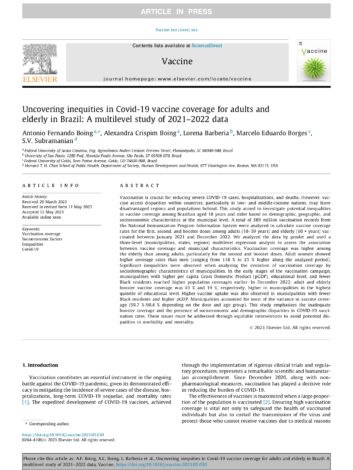Abstract
Vaccination is crucial for reducing severe COVID-19 cases, hospitalizations, and deaths. However, vaccine access disparities within countries, particularly in low- and middle-income nations, may leave disadvantaged regions and populations behind. This study aimed to investigate potential inequalities in vaccine coverage among Brazilian aged 18 years and older based on demographic, geographic, and socioeconomic characteristics at the municipal level. A total of 389 million vaccination records from the National Immunization Program Information System were analyzed to calculate vaccine coverage rates for the first, second, and booster doses among adults (18–59 years) and elderly (60 + years) vaccinated between January 2021 and December 2022. We analyzed the data by gender and used a three-level (municipalities, states, regions) multilevel regression analysis to assess the association between vaccine coverage and municipal characteristics. Vaccination coverage was higher among the elderly than among adults, particularly for the second and booster doses. Adult women showed higher coverage rates than men (ranging from 118 % to 25 % higher along the analyzed period). Significant inequalities were observed when analyzing the evolution of vaccination coverage by sociodemographic characteristics of municipalities. In the early stages of the vaccination campaign, municipalities with higher per capita Gross Domestic Product (pGDP), educational level, and fewer Black residents reached higher population coverages earlier. In December 2022, adult and elderly booster vaccine coverage was 43 % and 19 %, respectively, higher in municipalities in the highest quintile of educational level. Higher vaccine uptake was also observed in municipalities with fewer Black residents and higher pGDP. Municipalities accounted for most of the variance in vaccine coverage (59.7 %-90.4 % depending on the dose and age group). This study emphasizes the inadequate booster coverage and the presence of socioeconomic and demographic disparities in COVID-19 vaccination rates. These issues must be addressed through equitable interventions to avoid potential disparities in morbidity and mortality.
Keywords
Vaccination coverage; Socioeconomic factors; Inequalities; Covid-19


